By LISA VOGT/ Special to Asahi Weekly
February 20, 2024 at 07:30 JST
 Visitors pray at Munakata Taisha, which comprises three shrines devoted to the three Munakata goddesses: Okitsu-miya on Okinoshima island, Nakatsu-miya on Oshima island and Hetsu-miya on the Kyushu mainland. The deities have also been worshipped there for many years as the gods of mariners and for traffic safety on land as well. (Photo by Lisa Vogt)
Visitors pray at Munakata Taisha, which comprises three shrines devoted to the three Munakata goddesses: Okitsu-miya on Okinoshima island, Nakatsu-miya on Oshima island and Hetsu-miya on the Kyushu mainland. The deities have also been worshipped there for many years as the gods of mariners and for traffic safety on land as well. (Photo by Lisa Vogt)
The Munakata region lies northeast of the city of Fukuoka and faces the rough Genkai Sea. Sixty kilometers off the coast of Kyushu is Okinoshima, a sacred island between the Japanese archipelago and the Korean Peninsula. It is not quite a kilometer in physical size, but it is huge in its non-physical dimension as it showcases the evolution of Shinto rituals.
From the fourth century, the Munakata clan controlled the area and the sea route to the continent. They enjoyed considerable power and wealth from economic, political and cultural exchange with Korea, China and beyond via the Silk Road. It was a bustling place until the ninth century when political turmoil on the continent and discord with Japan cast a shadow on the once-vibrant international trade.
The roots of Shinto lie in people feeling the presence of kami in nature and thereby creating rituals. No formal shrines were built on Okinoshima, called the island where God resides. Instead, boulders and piled rocks called yorishiro, vessels that inhabit a spirit during religious ceremonies, were built and these provided a point for veneration.
Over 80,000 votive offerings (some even appearing from faraway Persia) have been found on the island and designated National Treasures or Important Cultural Properties.
No records exist of when Munakata Taisha was founded, but the shrine is mentioned in the Kojiki, the oldest existing record of Japanese history written in the eighth century. It comprises three shrines, each venerating one of three goddesses who were daughters of Amaterasu-Oomikami and Susanoo-no-Mikoto.
The main shrine, Hetsu-miya, was completed by the 12th century and is on Kyushu’s main island, making it the most accessible of the three. It is one of the oldest shrines constructed in the country and where the earliest Shintoism rituals were practiced.
A short ferry ride from the Kyushu coast takes you to Nakatsu-miya at the foot of Mount Mitake on Oshima island. It was built in the 17th century near the Amanogawa river of the Tanabata legend.
Okitsu-miya is on Okinoshima. The whole island is an object of worship and off limits to the public. It is believed that religious rituals began to take place on Okinoshima as conflict arose in and with the continent. The ancient Japanese belief is that a spirit resides in all things of this world, and people may be spared from chaos through purification and prayer.
A chronological history of evolving rituals based on the artifacts and their locations at Munakata Taisha tells the story of pre-, old and modern Shinto. Mighty impressive for a small island!
* * *
This article by Lisa Vogt, a Washington-born and Tokyo-based photographer, originally appeared in the Dec. 17 issue of Asahi Weekly. It is part of the series “Lisa’s UNESCO World Heritage Sites in Japan,” which depicts various parts of the country through the perspective of the author, a professor at Aoyama Gakuin University.




















A peek through the music industry’s curtain at the producers who harnessed social media to help their idols go global.
A series based on diplomatic documents declassified by Japan’s Foreign Ministry
Here is a collection of first-hand accounts by “hibakusha” atomic bomb survivors.
Cooking experts, chefs and others involved in the field of food introduce their special recipes intertwined with their paths in life.
A series about Japanese-Americans and their memories of World War II